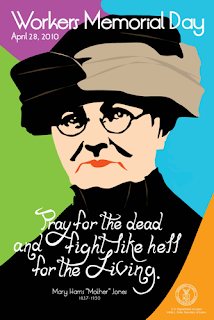 |
| United States Department of Labor poster, 2010, Wikipedia |
***
The first labor-related incident listed in Wikipedia's Timeline of labor issues and events is the Maine Indentured Servant's and Fisherman's Mutiny in 1636. Details of a similar incident in 1774 were reported by the U.S. Department of Labor:On August 5, 1774, just a month before the First Continental Congress convened in Philadelphia, the ship Needham landed in New York from Newry, England, Captain William Cunningham, master. The ship's cargo was white indentured servants. On arrival they protested to the authorities that they had been kidnapped in Ireland and had suffered "bad usage" on the voyage across the Atlantic. Whereupon the city fathers ordered them discharged. The servants had gained their freedom, but Cunningham nursed a grudge, and later, as the notorious provost marshal of the British army in America, he confined captured Patriots to atrocious prison ships and jails. The incident of the Needham's cargo dramatizes how the early American labor market was supplied. It also reveals that certain aspects of the old labor system were repugnant to that free society the American inhabitants sought to create for themselves.In time labor unions were established and these became vehicles for abuse themselves. Union Facts notes that
For too long, big unions have opposed employee rights, engaged in self-dealing and corruption, and made excessive demands that have killed tens of thousands of jobs and driven major cities into bankruptcy.The Great Depression in 1933 initiated a number of the conditions we saw paralleled following the Great Recession of 2008. Quoting from a previous version of the Department of Labor history--
...Following the stock market crash of 1929, the Hoover Administration urged and many industries and unions adopted work-sharing. For example, the United States Steel Corporation in 1929 had 224,980 full-time employees. The number shrank to 211,055 in 1930, to 53,619 in 1931, to 18,938 in 1932, and to zero on April 1, 1933. All who remained on the payroll on this last date were part time, and they were only half as numerous as those on full time in 1929.
Massive unemployment had a profound social and emotional impact upon American workers and their families. The movement of population, historically a response to economic opportunity, changed drastically when opportunity dried up. Immigration from abroad virtually stopped. The long-term shift from farm to city slowed significantly and there was, in fact, some reverse migration. The great population movement of the thirties was transiency, the worker adrift in a sea of unemployment. People, especially the young, girls as well as boys, took to the road because they could no longer bear to stay home. In the middle of the decade when the dust blew in the Great Plains, wiping out their farms, whole families of Okies, Arkies, and Mizoos migrated west, especially to California. The migrants often made their way to the junk-pile Hoovervilles with their Prosperity Roads, Hard Times Avenues, and Easy Streets. The destitute often lost their homes or farms because they were unable to make payments on mortgages.While Labor Day simply signifies the end of summer to many, there is a rich history associated with the historical intent of the day. There's also a Worker's Memorial Day on April 28th, "an international day of remembrance and action for workers killed, disabled, injured or made unwell by their work,"
John D. Rockefeller said (among other things):
I believe in the dignity of labor, whether with head or hand; that the world owes no man a living but that it owes every man an opportunity to make a living.
-- Marge

No comments:
Post a Comment